Note:
ZRD had very little interaction or knowledge regarding Lithium Battery Systems prior to July 2012. Due to numerous requests and the limited, sometimes erroneous information available, ZRD did an extensive inquiry into their construction and operation and their impact on marine operations. We have only scratched the surface and do not claim to have the same expertise that ZRD has in its regular business operations. ZRD has decided to pass on the following valuable information (that we have discovered so far) so that cruisers may make better informed decisions and choices.
A battery is an electrochemical device. It creates electricity through controlled chemical reactions between different substances. Most batteries include an anode, a cathode, and a substance between them serves as an electrolyte. The anode is usually the positive terminal and electric current flows into it when the battery is in use. The cathode is usually the negative terminal and electric current flows out of it. The chemistry between them is what provides the electric current with its charge, but they require a third substance in the form of an electrolyte to serve as a medium. If the anode and cathode come into contact, the result is a short circuit.
Lithium batteries use a variety of substances, with the common element being the migration of lithium between the electrodes during the electricity-producing reaction. Graphite is typically used to make the anode, while cathodes can be made from lithium cobalt oxide, lithium iron phosphate or lithium manganese oxide, and other lithium-based substances besides. The electrolyte is typically a solution of lithium salt in an organic solvent. When compared with a lead acid battery, lithium designs have a high power-to-weight and power-to-volume ratio. However, they are very complicated (expensive) to manufacture and their ability to hold a charge decays even when the battery is not in use.
Replacing the lithium cobalt oxide cathode material in lithium batteries with a lithium metal phosphate such as lithium iron phosphate, improves cycle counts, shelf life and safety, but lowers capacity. Currently, these 'safer' lithium batteries are mainly used in electric cars and other large-capacity battery applications, where safety issues are critical.
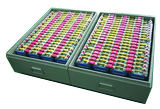
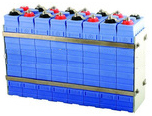 |
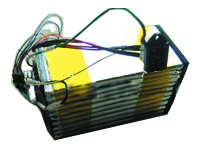
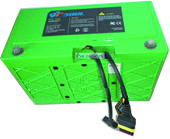 |
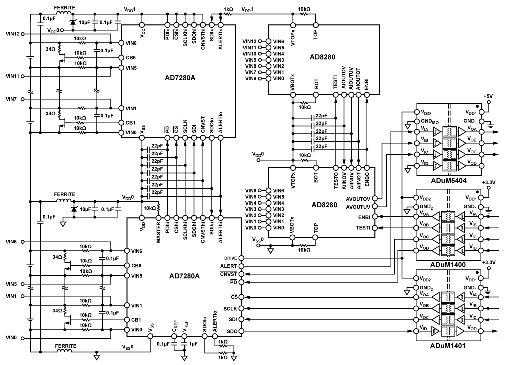 |
Above are images of various Lithium Batteries and a sample circuitry diagram of internal and external battery management components. One should immediately notice that Marine Lithium Battery systems require a significant amount of additional internal and external electrical components in order to adjust the charging within the various cells that make up a Lithium Battery. They also provide output connections to instrumentation and input for external battery management systems. The complexity of a Lithium Battery system should not be taken lightly. It is not as simple as just replacing your lead-acid batteries with Lithium- Even if you are starting from scratch and Even if you have spare $$$$$.
ZRD Investigative Research - Over a three week period, ZRD has had numerous conversations with professionals inside and outside of the Lithium Battery Industry. The following is what we have discovered.
Lithium Battery systems that are appearing for use in the marine environment had their start (origination) in the telecommunications industry. On the surface, they appear a great solution for the marine environment. Lithium batteries are 2/3 the weight of the same volume category (Group 27, 31, ...). They also allow a deeper discharge before a recharge is required. This amount varies between sales and technical to 80 to 100% discharge. In a cruising scenario, lead-acid charging is typically done using the 1/3 rule (50% to 85%) with a complete recharge to 100% required very 2 to 4 weeks using dock power. This difference yields a rough comparison of approximately three times the available amp-hours for the same size footprint with 2/3 of the weight. No wonder they seem so appealing. However, let us look at the bigger picture and see if using Lithium batteries makes sense in a marine environment.
Many battery manufactures require a charging voltage of 29.2vdc to charge their batteries. This is at least 1.0 volt higher than a typical lead-acid battery. Specific (non-standard) charging needs to be used to accommodate this required higher voltage charging requirement.
Battery bank sizing (ah capacity) is typically much smaller in the telecommunications industry than what is required for use in a marine environment. Consequently, they are charged from a dedicated, manufacturer specific designed, land based alternating-current charger using heavy duty non-moving parts. The charger has a low amperage output (typically less than 60 amps) due to the smaller capacity of these battery banks and the unlimited supply (time not a factor) of available shore power. We have not found any available chargers of larger output.
Lithium batteries use the term C/2 referring to their charging requirements. In simple terms, Lithium Batteries want to be recharged from a completely discharged state to a 95% charge in two hours. This would mean that if a vessel has a 1,000ah battery bank, it requires a charging source of at least 500 amps; a 2,000ah battery bank would require a charging source of 1,000 amps! This is not practical or realistic.
An additional component (current limiter) is required for any alternator based (used when not connected to dock power) charging source specifically matched to the charger's output. It must be installed on the output of the charger to limit its maximum output. This is due to the extremely low internal impedance (resistance) of a Lithium Battery system compared to a lead-acid battery. This difference is so great that the Lithium Battery system appears as a short circuit to the alternator. For dedicated Lithium Battery shore chargers, their design does not have this requirement due to the nature of their physically different construction. ZRD has not been able to locate a current limiter in excess of 60 amps. This greatly limits the practical size of an alternator based DC charger and ultimately the Lithium Battery bank size available for use. Without a current limiter installed, a Lithium Battery bank would need to be, at least, less than one-half to one-quarter the size of the available alternator output or damage to the alternator will occur. Alternators were/are designed to work with the internal resistance of Lead-Acid batteries. Without this resistance, the alternator components will significantly overheat and cause failure almost immediately.
In our discussions with Lithium Battery manufacturers, they were completely unaware of alternator requirements. They have never charged their batteries outside of land use.
Safety - Lithium batteries can rupture, ignite, or explode when exposed to high temperature. Short-circuiting a battery will cause the cell to overheat and possibly catch fire. Adjacent cells may then overheat and fail, possibly causing the entire battery to ignite or rupture. In the event of a fire, the device may emit dense irritating smoke.
Battery Fire Prompts Quick Action by FAA
The following is how Cessna Aircraft corporation originally represented the introduction of Lithium Batteries into their product line - very safe and wonderful. You be the judge after knowing the above.
"The Cessna Citation CJ4, certified on March 12, 2010, is believed to be the first civil aircraft with a Lithium Ion main battery. The 26.4VDC, 44Ah Lithium Ion main battery weighs 54 lbs., a 35% weight saving over a Nickel-Cadmium battery. Using phosphate-based Lithium Ion cells, which have no positive feedback thermal runaway failure mode, system integration of the battery and aircraft architecture design is simpler. Electronics and software are needed to optimize life only, not to ensure safety. Emergency discharge with failed electronics is enabled with the selection of a less volatile chemistry, the use of an analog Module Management System for cell balancing and protection, and the use of a micro-controller-based digital Central Monitoring System that reports health. System safety failure hazard assessment is considered Major, and the battery software is certified to the requirements of RTCA DO-178B, Design Assurance Level C. New Battery Fault and Battery Fail annunciations supersede the conventional Battery Over temperature messages to accommodate other non-temperature related failure modes. Heaters enable performance at cold temperatures while its aircraft-in-the-loop circuit ensures safety. The Lithium Ion battery and the Cessna Citation CJ4 electrical bus and avionics suite designs were integrated to optimize performance, safety, protection, and maintenance frequency."
Refer to a publication from Electrochem Commercial Power that Rutgers University referred to and used as part of their research, "Safety and handling guidelines for Electrochem Lithium Batteries"
Updates
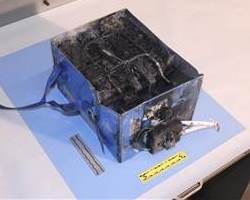 |
January 16, 2013 - Another FAA Directive issued. This one is the first of its kind in 3 decades. The Federal Aviation Administration ordered the immediate temporary halt of U.S.
Boeing Co.'s 787 Dreamliner flights, saying it requires a "corrective action plan" before flights can resume. The FAA said airlines would have to demonstrate that the lithium ion
batteries involved were safe before they could resume flying Boeing's newest commercial airliner, but gave no details on when that could occur. Among others, this action is a direct
result of the fire caused by Lithium Batteries on January 7, 2013.
April 19, 2013 - Carriers must install containment and venting systems for the main and auxiliary system batteries and replace battery chargers with modified components. I do not think these requirements will prevent future problems, only contain them. Much if not all of the available power to weight ratio is lost. April 25, 2013 - Boeing Won't Budge as Industry Abandons Lithium-Ion Battery - As hearings this week revealed lax FAA oversight of the lithium-ion batteries on Boeing's troubled 787 airline, competitors say there's no way they would use the still-unproven technology. Years after Boeing committed to using lithium-ion batteries in its 787 Dreamliner, other airplane makers developing advanced new jets have rejected the technology as too risky. A whole batch of new airplanes that will be flying soon have rejected lithium-ion batteries in favor of the older and well proven nickel-cadmium technology. "We looked at the technology and decided that lithium-ion batteries were not ready, not stable enough, to be used on our airplane," - Company Name withheld. |
Boeing 787 Dreamliner Incidents
7 January 2013 - B788, Boston MA USA - On a battery fire on a Japan Air Lines Boeing 787-8 began almost immediately after passengers and crew had left the aircraft after its arrival at Boston on a scheduled passenger flight from Tokyo Narita. The primary structure of the aircraft was undamaged. Investigation found that an internal short circuit within a cell of the APU lithium-ion battery had led to uncontained thermal runaway in the battery leading to the release of smoke and fire. The origin of the malfunction was attributed to system design deficiency and the failure of the type certification process to detect this.)
16 January 2013 - B788, En route Shikoku Island Japan, a main battery failure alert message accompanied by a burning smell in the flight deck was annunciated as an ANA Boeing 787-8 climbed through FL320 on a domestic flight. A diversion was immediately initiated and an emergency declared. A landing at Takamatsu was made 20 minutes later and an emergency evacuation completed. The Investigation found that the battery had been destroyed when thermal runaway followed a suspected internal short circuit in one of the battery cells and concluded that certification had underestimated the potential consequences of such a single cell failure.)
12 July 2013 - B788, London Heathrow UK - A fire broke out in the rear upper fuselage area of an unoccupied, parked and out of service Ethiopian Airlines’ Boeing 787 at London Heathrow. The ongoing investigation has found that the cause of the fire was a thermal runaway of all 5 cells in the Lithium-metal battery pack which powers the ELT fitted at that position. It has also significantly concluded that the current FAA-approved certification process for the use of lithium-metal batteries in aircraft equipment is fundamentally flawed in respect of the mitigation of the risk of fire and that corrective action is required.)
The worrying question: are the standards Boeing has met to re-certify the batteries tough enough? Boeing admits that the exact cause of the two battery meltdowns that caused the grounding of the fleet has not been nailed and may never be. Whatever happens, Boeing finds itself in a lonely place as a true believer in the technology.
For those of you that still think Lithium is OK to use and problems are "Fake News" from the past,
Posted in a different forum on Jul 26, 2019, "I put a lithium in my Ducati 996 and it caught fire, lost the bike, even my tears wouldn't put it out."
Summary
ZRD has only scratched the surface with its investigation of Lithium Battery systems in a marine environment, but we already appear to know more than the battery manufacturers themselves. In no way does this make ZRD experts in Lithium Battery solutions, but we have determined that this industry is in its infancy. There are no industry-wide standards for design or safety. When combined with the above information, ZRD is not currently able to suggest or recommend any Lithium Battery system or manufacturer for marine use. It is ZRD's opinion, that until a fully developed system is designed and in safe operational use, Lithium Batteries should remain in the telecommunications system where they originated and not be used in the marine environment. This will enable the least damage to equipment or personal exposure to hazardous risks. Until their technology catches up / improves and becomes uniform, Lead-Acid (standard wet cell or AGM) Batteries is the only safe and realistic venue for marine operations at the current time.
Additional Note: The Lithium battery discussion above applies to cruising vessels and their large battery bank requirements. Sometimes small runabout fishing vessels may use 1 or 2 Group 27 or 31 Lithium batteries instead of a large lead-acid battery bank for overnight operations. This gives them the capacity of a large lead-acid battery bank they need for extended run times without the requirement for considerable additional space or weight. The key to this is that they charge the battery(s) when they get back to shore using a dedicated Lithium 120 Vac charger. They do not do charge at sea or they may experience the same problems and be exposed to the safety risks described above. Even in this situation, due to the extreme high cost of Lithium batteries, they are still rarely used.
ZRD suggests you search the web yourself to gain additional information. This is just the basics of what we have discovered after many hours of investigation.
